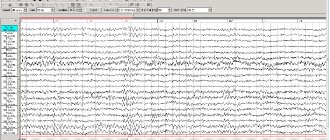Causes
A headache does not always mean the presence of a disease.
It can also occur as a response to negative environmental factors (lack of oxygen, stuffiness, smoke), due to long hours of work, hunger, hangover or lack of sleep. However, this symptom should not be ignored, because headaches can also be the result of a variety of diseases of the brain, nervous system and internal organs.
Viral gastroenteritis
Any inflammatory process in the body causes headaches, including infectious lesions of the stomach and small intestine - viral gastroenteritis. Rotavirus is the cause of 40% of cases of acute intestinal infections in children under 14 years of age and 55-60% in children under 5 years of age.
Inflammation begins after various viruses enter the gastric mucosa:
- rotaviruses - one of the main causative agents of gastroenteritis;
- caliciviruses - released into the external environment along with the feces of an infected person;
- intestinal adenoviruses, especially dangerous for young children;
- astroviruses, transmitted mainly by contact.
The main symptoms of acute viral gastroenteritis:
- diarrhea,
- nausea and vomiting,
- headache,
- general weakness,
- tachycardia.
As the disease progresses to the chronic stage, periodic headaches persist and stomach pain appears after eating. Diagnosis is based on taking a medical history and identifying the pathogen.
Brain aneurysm
A pathological protrusion of the walls of blood vessels supplying the brain is called an aneurysm. The danger of the disease is that a person may not suspect a “time bomb” in his own head for a long time and only learn about it when a blood vessel ruptures. Very often, an aneurysm is diagnosed during a routine medical examination.
Thinning and stretching of the vessel wall can lead to hemorrhagic stroke - bleeding in the brain. Risk factors for developing an aneurysm include heredity, trauma, cardiovascular disease, and bad habits (Fig. 1).
Figure 1. Factors that increase the risk of aneurysm. Source: MedPortal
The headache caused by an aneurysm is caused by the pressure of the blood-filled sac-like bulge on the nerves and surrounding tissue. Attacks of pain are similar to migraines and most often affect the back of the head.
Stroke
A stroke is a vascular accident that damages parts of the brain. Acute cerebrovascular accident occurs either due to a decrease in the lumen of the cerebral arteries (cerebral infarction or ischemic stroke) or due to rupture of a vessel and hemorrhage in the brain (hemorrhagic stroke).
A sharp headache is characteristic of a hemorrhagic stroke. The rupture of a vessel and blood pressure on the nerve endings of the meninges cause severe suffering to a person. Pain during a stroke has different localization, affecting the back of the head, the forehead or the entire head (Fig. 2).
Figure 2. Symptoms of a stroke. Source: MedPortal
Pain during an ischemic stroke may be absent or mild.
Important! At the first sign of a stroke, you should immediately call an ambulance! Doctors may have only 4.5 hours to save a patient.
Brain tumor
Neoplasms in the brain, regardless of etiology, always cause headaches. This is due to the fact that as the tumor grows, it begins to put pressure on the nerve endings located inside the skull and affects the meninges and blood vessels. Pain is also caused by increased intracranial pressure due to an enlarging tumor.
The intensity of pain depends on the size of the tumor and its location. In the initial stage of the disease, a person does not feel any discomfort and does not consult a doctor. When symptoms become severe, the tumor is often quite large and affects large areas of the brain.
If the neoplasm affects peripheral vessels, painful attacks are migraine-like. Sometimes the pain syndrome is accompanied by nausea, clouding of consciousness, and convulsive seizures.
Hypertonic disease
People suffering from high blood pressure often complain of headaches in the back of the head. The pain may be throbbing, pressing or aching.
Pain in hypertension is due to the fact that when blood vessels lose elasticity, the blood flow puts pressure on the vascular nerve endings. This pain is typical for older people who have suffered from hypertension for a long time.
At a younger age, a person may not experience any unpleasant symptoms of high blood pressure and learn about the problem only during a routine medical examination.
Increased intracranial pressure
Intracranial hypertension is a neurological diagnosis associated with impaired circulation of cerebrospinal fluid. The causes of high blood pressure are most often associated with the presence of other diseases or due to reasons not directly related to the brain:
- the use of vasoconstrictors, antibacterial, hormonal and some other groups of drugs;
- vascular atherosclerosis, hematomas, blood clots and other obstacles to the cerebrospinal fluid;
- stroke, encephalitis and other disorders of the nervous system;
- renal pathologies;
- brain tumors and hematomas;
- toxic lesions;
- problems with the endocrine system;
- congenital pathologies, for example, hydrocephalus.
Headache is the main symptom of increased intracranial pressure, but a comprehensive examination is required to determine the causes of the pathology.
Cervical osteochondrosis
Cervical osteochondrosis and the pain associated with it are our retribution for long hours spent at the computer and reluctance to walk. Causes of degenerative-dystrophic lesions of intervertebral discs and muscle spasms:
- overweight and obesity,
- poor nutrition,
- stress and emotional stress,
- excessive zeal in the gym and incorrect technique for performing strength exercises,
- sedentary work.
All of them are directly related to the wrong lifestyle. Damage to the cervical vertebrae and intervertebral discs can also be a consequence of trauma and congenital abnormalities of the spine.
Without proper treatment, osteochondrosis can be accompanied by increasing pain in the head and back, poor circulation and the formation of a hernia.
Neck myogelosis
Very severe headaches occur with myogelosis - thickening of the muscles in the neck, although painful nodules can also appear in other parts of the spine. Seals occur due to changes in the structure of muscle protein; they are easily palpated.
The main causes of myogelosis:
- sedentary work, sedentary lifestyle,
- hypothermia and drafts,
- nervous tension causing muscle spasms,
- scoliosis.
Myogelosis can develop against the background of cervical osteochondrosis, herniated intervertebral discs and inflammatory processes in the musculoskeletal system. Risk factors also include arterial hypertension, injuries and sprains, and professional sports.
Myogelosis headache torments a person with any turn of the head or change in body position. The disease is difficult to diagnose because its symptoms are similar to many other spinal pathologies.
Combined with nausea
Severe headache and nausea are signs of migraine, meningitis, and hypertensive crisis.
Often the cause of these symptoms is sinusitis, sinusitis, or intoxication of the body. Nausea, headache, and dizziness are also symptoms of traumatic brain injury and infectious diseases. Patients complain of headache, nausea, weakness at the initial stage of influenza and acute respiratory infection. In this case, the body temperature rises to high numbers. The development of a migraine can be signaled by ripples in the eyes, nausea and headache. With a migraine, the patient's appetite disappears, an aversion to strong odors appears, nausea, irritability, photophobia, and numbness in certain parts of the body occur.
Headache and dizziness also occur when wearing incorrectly selected glasses or lenses or disruption of the vascular system. Headaches and spots in the eyes appear due to fatigue and nervous exhaustion, during weather changes, after stress. These symptoms occur in people who have suffered a traumatic brain injury, spinal injury or disease.
Headache and flashing spots before the eyes appear during a hypertensive crisis. Its variety - hyperkinetic crisis - begins abruptly with headache, nausea, flickering of spots before the eyes and vomiting. The patient feels hot. His sweating and heart rate increase. Trembling is felt throughout the whole body. High blood pressure can cause hypertensive encephalopathy. It manifests itself with the following symptoms:
- Very severe headache;
- Dizziness;
- Nausea;
- Vomiting;
- The flickering of flies in the eyes.
The patient may lose consciousness and die if medical care is not provided in a timely manner.
Headaches that occur in the morning after sleep can be a manifestation of a brain tumor, abusive cephalalgia, tension pain, or migraine. Overuse headache occurs with long-term use of analgesics. It gets worse in the morning. The intensity of the pain constantly changes throughout the day. Overuse headaches are aggravated by stress, mental tension, excessive physical activity, and also by stopping a drug that relieves pain. Abuse cephalgia becomes permanent if the patient suffers from depressive syndrome, is often irritated, and is very tired. Due to constant headaches, a person’s concentration and performance decrease. He sleeps poorly and constantly feels tired.
Other reasons
Headache can be caused by other reasons:
- hormonal changes in the body during pregnancy, with the onset of menopause,
- some diseases of the endocrine system - hyperthyroidism, diabetes mellitus, dysfunction of the adrenal glands;
- acute respiratory diseases;
- sinusitis, otitis, sinusitis, tonsillitis;
- traumatic brain injury, concussion;
- infectious lesions;
- chronic inflammatory processes in the body.
Headache, pills and chewing gum
Sometimes a headache can occur due to a completely unexpected reason. For example, headaches that occur while taking certain painkillers are called headaches.
An interesting study was conducted by Israeli scientists. They found that young people and teenagers who constantly chew gum often experience headaches. This is due to tension in the temporomandibular system due to continuous load during chewing movements.
Such a variety of causes of headache requires special attention to the nature of the sensations, the localization of the source of pain, and its intensity. A symptom checker can sometimes reveal more about the source of the problem.
However, only a thorough history taking and a comprehensive examination will help establish the correct diagnosis and determine treatment tactics.
Causes of headaches in women
When developing tactics for managing a patient with headache, neurologists at the Yusupov Hospital take into account its cause. Doctors relieve headaches with analgesics and at the same time treat the disease that caused this syndrome. Most often, headaches in women occur for the following reasons:
- Hormonal imbalances;
- Acute or chronic stress;
- Increase or decrease in blood pressure;
- Dysfunction of the autonomic nervous system;
- Diabetes mellitus;
- Infectious diseases (meningitis, encephalitis, tuberculosis);
- Inflammation of the neck muscles:
- Osteochondrosis of the cervical spine;
- Volumetric formations of the brain.
Classification
In modern clinical practice, the classification developed by the classification committee of the International Headache Society is used. In accordance with it, headaches are divided into primary, secondary and neuralgia.
Primary pain
The main pain of this type is migraine. It is not associated with any pathologies of internal organs, systemic diseases or injuries. Primary headaches also include:
- tension is the most common type of pain,
- after physical stress, sex, emotional stress,
- during long flights, climate change, sudden changes in weather,
- cluster.
The cause of primary pain is the chemical activity of brain cells and blood vessels and the increased sensitivity of pain receptors.
Secondary pain
Secondary pain is always associated with an existing disease. They may be a symptom:
- osteochondrosis,
- colds or viral diseases,
- hypertension,
- brain tumors,
- traumatic brain injuries and many other pathologies.
Neuralgia
Neuralgia is a condition caused by damage to the peripheral nerves. Severe headaches occur with inflammation of the trigeminal, glossopharyngeal, and occipital nerves. Neuralgia can be of a different nature and vary in intensity, appear suddenly or gradually increase.
Inflammation of the nerves can occur due to stress, hypothermia, problems with the immune system, or prolonged fasting.
In the eye and forehead area
Headaches in the forehead area are caused by various factors.
Cluster or beam pain occurs in the eye area. She may return after a while. Sometimes attacks continue for several hours. A headache that radiates to the eyeball can be a sign of migraine, eye diseases, brain tumors, and neurological diseases of the brain. It often occurs after severe or prolonged stress. The cause of the headache may be inflammation of the maxillary or frontal sinuses. It often radiates into the eyeballs. Sinus headache disappears after the underlying disease is cured. Pain in the forehead is a common symptom of meningitis, malaria, typhoid, and pneumonia.
Different types of headaches
Doctors identify more than 250 types of headaches, but some of them are more common than others (Fig. 3).
Figure 3. Common types of headaches. Source: MedPortal
Tension
Tension or tension headaches are the responsibility of a neurologist. This is the most common and varied type of pain. It can cover just one area, such as the forehead or back of the head, or spread over the entire head (Fig. 4).
Figure 4. Tension headache. Source: MedPortal
According to subjective sensations, tension pain resembles compression of the skull and muscle tension. People who spend a lot of time at the computer, lead a sedentary lifestyle, truck drivers, seamstresses, and office workers are most prone to tension pain.
You can get rid of periodic tension pains by changing your lifestyle and including mandatory walks in the fresh air and gymnastics in your daily routine. You should also avoid stressful situations and excessive physical activity if possible.
Post-traumatic
Pain can appear not only after a head blow, but also after any spinal injury, and not immediately after it, but after several weeks or months.
Special treatment for such headaches is not required; the condition can improve after general restorative procedures prescribed to eliminate the consequences of injury: gymnastics, massage, normalization of sleep and diet.
Migraine
Migraine is one of the most intense headaches, usually affecting half of the skull (Fig. 5). An attack can be triggered by certain foods, stress, an irritant in the form of an unpleasant or simply concentrated odor, or a bright flashing light.
Figure 5. Pattern of pain in migraine. Source: MedPortal
Migraine is often accompanied by nausea, dizziness, and general weakness. It mainly affects middle-aged women. There is no single method of treating migraines, but your doctor will help you choose medications that relieve unpleasant symptoms.
Migraine aura
About 25% of people suffering from migraines see black dots or bright lines in front of their eyes, hear extraneous noises, or smell an intrusive odor before attacks of pain. It's all an aura, and it usually ends when the pain begins. Another possible companion to migraine is Alice in Wonderland syndrome, when a person is unable to adequately perceive his own size in space.
Sinus
Most often, such pain is associated with inflammation of the nasal sinuses, so they are localized in the area of the bridge of the nose or forehead (Fig. 6). The pain is very severe and occurs against a background of difficulty breathing, nasal congestion, fever, and swelling. Antihistamines (if the cause of nasal congestion is an allergy) or antibiotics prescribed by a doctor can help get rid of such pain.
Figure 6. Characteristics of sinus headaches. Source: MedPortal
Cluster
Such intense acute pains are mainly characteristic of men and are difficult to treat. The attacks can be short-lived, but sometimes last a day or more. The pain is pulsating in nature, usually localized in the eye area, accompanied by swelling of the nasal mucosa and lacrimation.
Infectious
Almost all infectious diseases are accompanied by headaches of varying nature and intensity. The pain goes away after successful treatment of the underlying pathology.
Hypertensive
An increase in blood pressure is often accompanied by a nagging pain in the occipital region. This is especially true for older people. After taking antihypertensive drugs and normalizing the condition, the pain goes away, however, it can appear with a sharp decrease in pressure.
Hormonal
Headache due to changes in hormonal levels is familiar to most women before the onset of menstruation. Similar pain occurs in women in the early stages of pregnancy and during menopause. Most often, discomfort is felt in the upper part of the head and temples. Menopausal pain can be relieved by selecting compensatory therapy from a specialist.
Tumor
As the tumor grows in the brain, the pain intensifies. Usually the attack begins in the morning and is accompanied by nausea and dizziness. The symptoms in this case are relieved with painkillers, the pain goes away after defeating the tumor.
Caused by intracranial bleeding
When a vessel ruptures, pain appears suddenly and is usually accompanied by vision problems, slurred speech, and loss of orientation. Such symptoms require urgent medical attention.
Related to trigeminal nerve injury
The trigeminal nerve hurts in sharp, pulsating short attacks, the pain covers the entire head or only the face area. Anticonvulsants and physiotherapeutic procedures are prescribed to relieve pain.
Cervicogenic headache
The pain is associated with problems in the cervical spine and is usually localized only on one side. Pain can occur when you move your head suddenly or when you change body position. Complex therapy includes muscle relaxants, nonsteroidal anti-inflammatory drugs, and anticonvulsants.
Migraine
Signs. Severe attacks of throbbing pain in one part of the head, lasting from 1-2 hours to several days. Often this pain is hereditary, affecting mostly women aged 25 to 35 years. A severe migraine is accompanied by nausea and vomiting, blurred vision, dizziness, drowsiness, and irritability. Before a migraine attack, a slight tingling sensation is felt throughout the body.
Causes. The cause of migraine is usually vascular disorders in the head and neck and fundus of the eye. During a migraine attack, the blood vessels in the head dilate and electrical activity occurs in the cerebral cortex. The pain is triggered by a stressful situation, mental stress and fatigue, sleep disturbance, changes in atmospheric pressure, menstruation or pregnancy in women, menopause.
Treatment. It is impossible to relieve migraine symptoms, but you can reduce them slightly. To do this, you need to retire to a quiet, darkened room, do acupressure, and a cold compress on the forehead. Sometimes, on the contrary, a warm shower or washing your hair with hot water helps. Traditional painkillers are of little help for migraines. Exercise and a healthy lifestyle can improve the condition.
When to call an ambulance
Immediately dial 103, 112 or go to the nearest emergency department immediately if there are other symptoms besides severe pain Headaches: When To See A Doctor:
- Temperature above 39 °C.
- Problems understanding speech.
- Slurred speech, slurred language, unnatural pauses between words.
- Sudden vision problems: blurred vision, white or dark spots appearing before the eyes.
- Numbness, weakness, or paralysis on one side of the body.
- Stiffness in the neck muscles. It manifests itself in the fact that a person cannot tilt his head back towards his shoulders or press his chin to his chest.
- Rocking, uneven gait.
- Confused consciousness.
- Fainting.
- Nausea or vomiting (unless clearly related to the flu or hangover).
All this can indicate a severe infection, acute cerebrovascular accident and other serious health problems, which without timely help can even lead to death.
And only if there are no threatening symptoms, it makes sense to listen to the sensations in order to determine the type of headache and understand how to cope with it.
Temporal headache
Severe headaches in the temples bother patients with otitis media and migraines.
It occurs when intracranial and blood pressure increases. One of the causes of pain in the temple area is inflammation or injury to the temporomandibular joint. In this case, pain occurs in the temple area and radiates to the ear and eye. Sometimes painful sensations occur in the shoulder, neck, and shoulder blade. If the temporomandibular joint is not positioned correctly, muscle spasm develops, which causes increased headaches. After treatment of the underlying disease, the pain goes away. One of the causes of headaches in the temple area is arteritis. This is a disease in which the inflammatory process affects the vessels of the head and temporal region. Due to autoimmune inflammation of the walls of arteries and large vessels in the temporal region, immune complexes are deposited on their walls, which are produced in response to infection. The immune system perceives these cells as foreign. The walls of the blood vessels thicken and blood clots form on them. This pathology is manifested by severe headache in the temple area, general weakness, and impaired visual function. As the disease progresses, arterial damage leads to organ failure.
A common cause of pain in the temple, in the eye area and severe pressing pain in the skull is stress. With deterioration of memory, hearing, vision and constant throbbing severe pain in the temple area, a neurologist may suspect the development of a brain tumor.
Sharp pain in the temple area is a common symptom of a stroke. It is accompanied by numbness on one side of the face, body, and loss of speech. Hemorrhagic stroke can occur due to a rupture of a cerebral artery aneurysm. Acute vascular accident develops as a result of stress. Its harbinger can be a severe headache.
Venous headaches
Headache bothers patients who have impaired outflow of venous blood from the cranial cavity. The following diseases lead to dysfunction of intracranial veins:
- Neoplasms;
- Hematomas;
- Previous stroke;
- Congenital defects in the development of venous vessels.
Venous pain is dull in nature. It occurs on both sides of the head, in the morning. The patient is bothered by a feeling of fullness, pressure, heaviness in the head. Then there is dizziness, buzzing, noise in the head. The earlobes, tip of the nose, and lips may become bluish. The pain intensifies during stress, weather changes, and after drinking alcohol. Due to stiffness throughout the body, it is difficult for a person to get out of bed in the morning. During the day he feels lethargic, as if he had not slept at all at night.
Headache with cervical osteochondrosis
With the development of cervical osteochondrosis, the nerve roots extending from the spinal cord are compressed.
Patients are bothered by neck pain that radiates to the head. The vertebral arteries run along the spine in the neck area. They carry oxygen through the blood to the brain. With cervical osteochondrosis, the blood flow in them is gradually disrupted. This occurs due to compression of the vessel by a displaced spinal disc, a strained muscle, or a bony growth on the vertebra. Without adequate therapy, disorders increase, and vertebral artery syndrome gradually develops. It is manifested by headaches, dizziness, frequent loss of consciousness (especially with sudden turns of the head), severe fatigue and decreased performance.
Vascular headaches
Headache develops in patients suffering from diseases of the cardiovascular system:
- Arterial hypertension;
- Atherosclerosis;
- Stroke;
- Cerebral atherosclerosis, thrombosis;
- Hemorrhage under the membranes of the brain;
- Vegetovascular dysfunction.
With a strong increase in blood pressure, pain nerve endings in the walls of blood vessels are excited: when the brain begins to receive less oxygen, it reacts with pain. Typically, vascular headaches occur in the temples. It is often combined with the following symptoms:
- Noise, feeling of congestion in the ears;
- Flashing “flies before the eyes”;
- Dizziness;
- Nausea, vomiting;
- Transient visual impairment.
Sometimes headache becomes the first symptom of vascular pathology.









